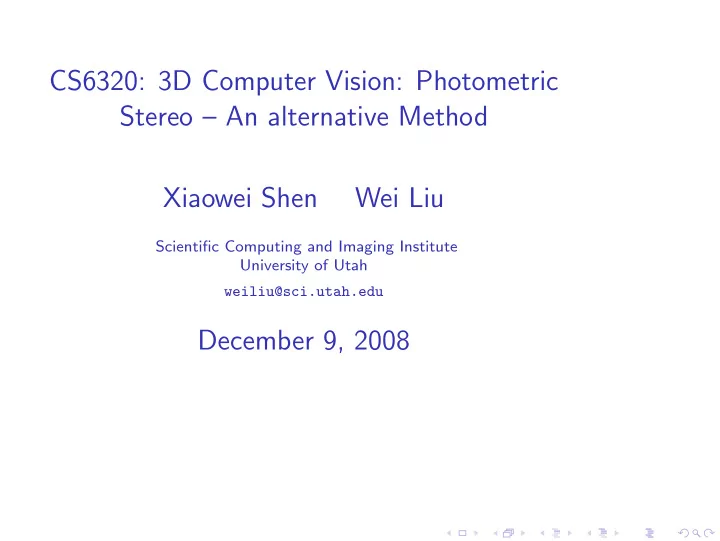

CS6320: 3D Computer Vision: Photometric Stereo – An alternative Method Xiaowei Shen Wei Liu Scientific Computing and Imaging Institute University of Utah weiliu@sci.utah.edu December 9, 2008
Overview ◮ In this project we use various images of same objects under different light source direction to recover the albedo and normal of the object, then contruct a 3D depth map using normals. ◮ This is a student project by Dr. Steve Seitz on his year 2005 Computer vision class. The project page gives the method to compute the normal, albedo and 3D depth map. As it was well documented and closed related to our 3D computer vision class, we decide to follow that project. 2/9
Some Highlights The method we use is closed related to the assignment two but there is also difference: ◮ The light source direction is unkown. we need to caculate the direction of the source based on a ’chrome’ image under the same light source conditions. As we know the shape of the sphere, we compute the source light direction if we can compute the ’lightspot’ of each chrome images. ◮ To get the normals, we use the same method in assignment two. But for albedos, we use another least square method. As the original images are color images, we can get the albedos map for each R, G, and B channels. ◮ Use alternative method to recover the depth map. As the normal is orthogonal to the surface, it is perpendicular to any line/vector on the surface, including the vector from ( i, j, z ( i, j )) to ( i + 1 , j, z ( i + 1 , j )) and the vector from ( i, j, z ) to ( i, j + 1 , z ( i, j + 1)) . We can use this property to get a linear equation for the depth z ( i, j ) , and try to solve the over-constrained least square problem. 3/9
Bright spot of Sphere, by Wei Liu To get the light direction from the ’chrome’ image, we need first to know the bright spot of the sphere[2]. This is done by weighted averaging the pixels of the ’chrome’ image. As there are same number of chrome image as the light source direction, we can get 10 bright spot from the 10 chrome images. When programming, only the pixels with intensity value > 0 . 9 are considered. This is to guarantee the noise are excluded from the computation. 4/9
Light Source Direction, by Wei Liu and Xiawei Shen as the image is taked over the object, we can assume the vector from the viewer to the specular point is perpendicular to the XY plane, so we can assume the vector from the specular point to the viewer is [0 0 1] we have the normal and the vector R = [0 0 1], we can use a geometry method to get the light direction. Look at the figure below [1]: By the geometry of the figure we can get the light direction R as R = 2 · N ( N · L ) − L Whre N is the normal of the point, and L is the viewer’s direction ([0 0 1]). 5/9
Get Normals and Albedos, by Wei Liu With the direction of the light source available in previous section, we use the same method to compute the normal and albedo with the assignment two [3] 6/9
Get 3D surface map, by Xiaowei Shen Any vector within the surface are perpendicular to the normal. The vector from ( i, j, z ( i, j )) to point ( i, j + 1 , z ( i, j + 1)) is perpendicular to the normal of point ( i, j ) . Similarly, the vector from ( i, j, z ( i, j )) to point ( i + 1 , j, z ( i + 1 , j )) is also perpendicular to the normal. Thus for the same point p we get two linear equation of the surface (the z coordinate). Th is is again a over-constrained system M · P = z . As M is extremely large ( it have roughly 2 N rows where N is the total number of the pixels under consideration), we have to use some methods like sparse matrix to store and compute this linear system. 7/9
Results The R, G, and B albedo map for the ’buddha’ object The normal’s needle map and the 3D surface: 8/9
Reference Scott Owen. Methods to compute VR. 1999. Steve Seitz. Project 3: Photometric Stereo. 2005. Robert J. Woodham. Photometric method for determining surface orientation from multiple images. Optical Engineering , 19(1), Jan/Feb 1980. 9/9
Recommend
More recommend